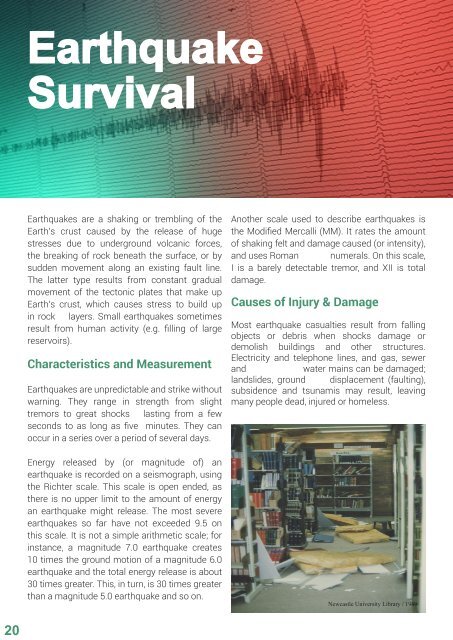Emergency Dispatch Vol 4 2014
You also want an ePaper? Increase the reach of your titles
YUMPU automatically turns print PDFs into web optimized ePapers that Google loves.
20<br />
Earthquake<br />
Survival<br />
Earthquakes are a shaking or trembling of the<br />
Earth’s crust caused by the release of huge<br />
stresses due to underground volcanic forces,<br />
the breaking of rock beneath the surface, or by<br />
sudden movement along an existing fault line.<br />
The latter type results from constant gradual<br />
movement of the tectonic plates that make up<br />
Earth’s crust, which causes stress to build up<br />
in rock layers. Small earthquakes sometimes<br />
result from human activity (e.g. filling of large<br />
reservoirs).<br />
Characteristics and Measurement<br />
Earthquakes are unpredictable and strike without<br />
warning. They range in strength from slight<br />
tremors to great shocks lasting from a few<br />
seconds to as long as five minutes. They can<br />
occur in a series over a period of several days.<br />
Energy released by (or magnitude of) an<br />
earthquake is recorded on a seismograph, using<br />
the Richter scale. This scale is open ended, as<br />
there is no upper limit to the amount of energy<br />
an earthquake might release. The most severe<br />
earthquakes so far have not exceeded 9.5 on<br />
this scale. It is not a simple arithmetic scale; for<br />
instance, a magnitude 7.0 earthquake creates<br />
10 times the ground motion of a magnitude 6.0<br />
earthquake and the total energy release is about<br />
30 times greater. This, in turn, is 30 times greater<br />
than a magnitude 5.0 earthquake and so on.<br />
Another scale used to describe earthquakes is<br />
the Modified Mercalli (MM). It rates the amount<br />
of shaking felt and damage caused (or intensity),<br />
and uses Roman numerals. On this scale,<br />
I is a barely detectable tremor, and XII is total<br />
damage.<br />
Causes of Injury & Damage<br />
Most earthquake casualties result from falling<br />
objects or debris when shocks damage or<br />
demolish buildings and other structures.<br />
Electricity and telephone lines, and gas, sewer<br />
and<br />
water mains can be damaged;<br />
landslides, ground displacement (faulting),<br />
subsidence and tsunamis may result, leaving<br />
many people dead, injured or homeless.<br />
Newcastle University Library / 1989





